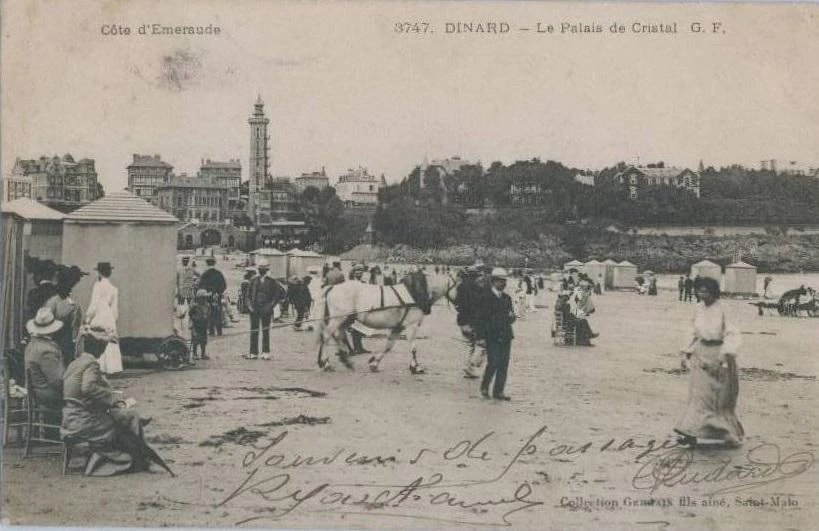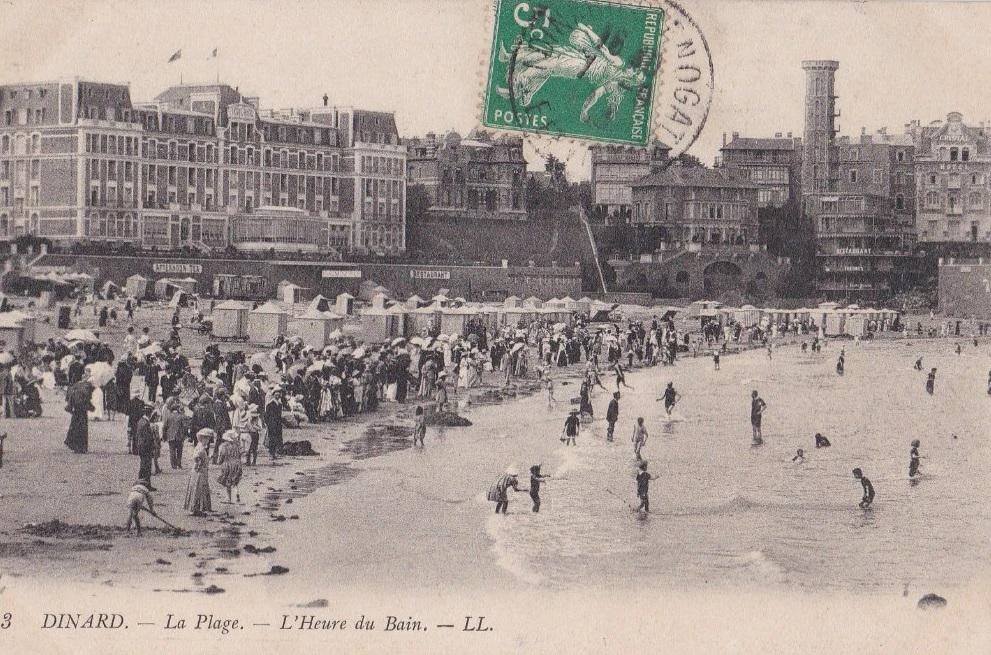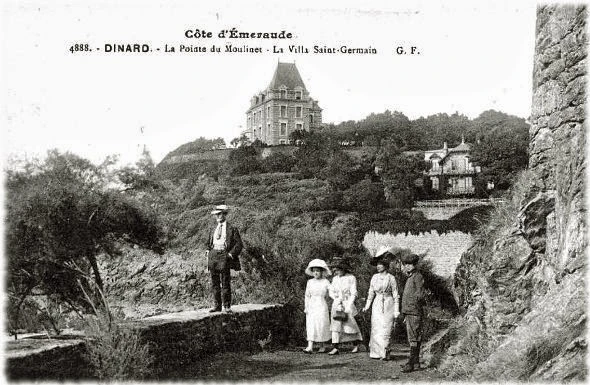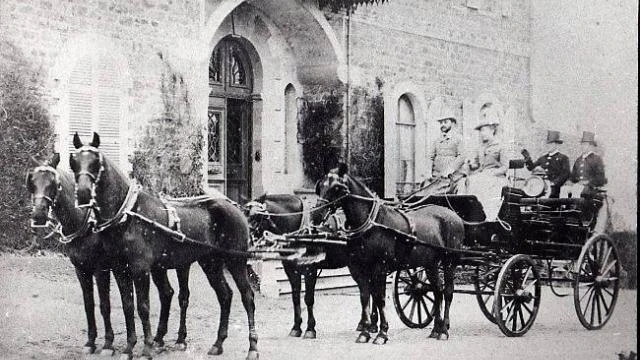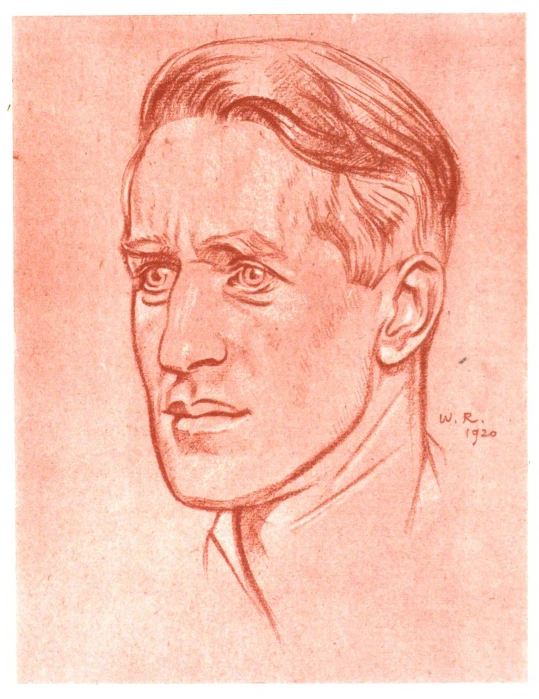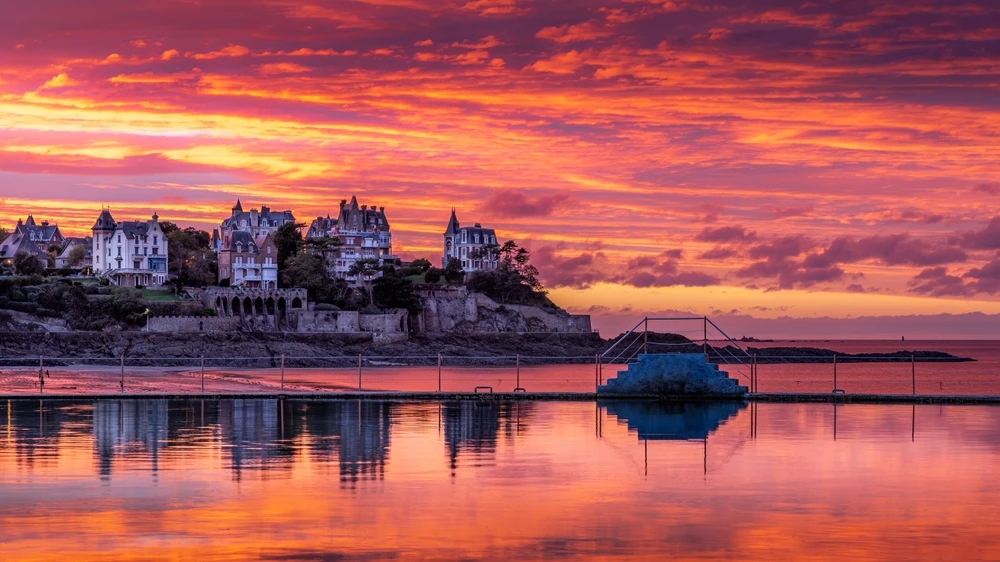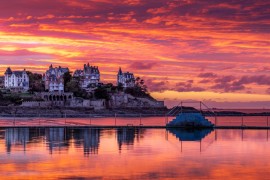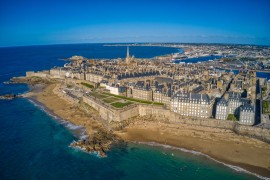Dinard or the history of a seaside resort
Dinard: the beach and the famous blue and white canvas tents which sign the city. Photo chosen by monsieurdefrance.com: shutterstock.
A hamlet for several centuries.
Dinard, until the middle of the XIXth century, was only a hamlet of St Enogat, a Breton parish which supplied Saint Malo with sailors, food and also fertilizer, thanks to the dejections of birds on the rocks. The place is one of the rare republican places during the Chouane period, and we are still talking about the village, the countryside being rather Chouannes. Saint Enogat, which takes its name from the 5th bishop of Aleth (Saint Malo) is made up of a village, on the edge of the sea but which turns its back to it and of many hamlets like the Priory, for example, founded by monks of the Middle Ages in the XIIth century, "la grande lande" (the great moor), the pionnière (whose street of the pionnière perpetuates the memory) and Dinard: a port. Well rather than a port, a fishing village and especially a crossing point of the West Breton towards Saint Malo, the opulent commercial city. One takes a ferry, very taxed by the way, which leads to the Corsair City, in particular to sell cloths woven in the countryside with the hemp which likes well in Brittany. A place like so many others, except for a short appearance in History when Duke Jean IV of Brittany landed on August 3, 1379 in Dinard, from England, to reconquer his duchy. What will change everything is tourism.
Seal of Duke John IV of Brittany / Image selected by monsieurdefrance.com
A crush that launched Dinard
It is an American couple, William and Lyona Faber, who will launch the seaside resort of Dinard around 1835 by discovering the site thanks to an English friend who already knew it, perhaps after having been a prisoner in Saint Malo during the imperial wars. It is in any case to the Faber couple that we owe one of the first villas built to take advantage of the magnificent view of Saint Malo. Aware of the potential of the place, at a time when tourism was developing more and more among aristocrats and a certain bourgeoisie, the Fabers bought land and sold it to their English friends, especially those from Dinan, who were soon numerous enough to justify the appearance of a British Consul and the creation of an Anglican church, Saint Barthelemew (which is still in its place today). The English will make their mark in Dinard and put in fashion what they have already been practicing for a long time across the Channel: sea bathing.
The first sea baths in Dinard
One of the cabins that brought the bathers to the waterfront in Dinard. Photo chosen by monsieurdefrance.com: old postcard.
While medicine was beginning to see sea bathing in a positive light, and it was already fashionable to go swimming in Great Britain, this fashion for sea bathing reached France and in particular Dinard, which saw the establishment of a sea bathing establishment and the arrival of its first bathers. We see them approaching the water on the beaches, especially the beach of Ecluse. The ladies also bathe, dressed in large bathing suits that cover them, and brought to their cabins on horse-drawn carriages that put them as close to the water as possible because it would be indecent for them to be seen so scantily clad. At the same time, the big fortunes begin to build their villas. Coppinger completed his in 1858. They compete in beauty and ingenuity. Everything was possible for the architects, from the English villa with turrets and bow windows to residences inspired by local malouinières. The hotels are more and more numerous and more and more chic. From the hamlet of Dinard, the seaside town widens towards the Pointe du Moulinet, the Plage de l'Ecluse to the point that one starts to speak about Saint Enogat Dinard, before speaking only about Dinard 50 years after the arrival of the first tourists.
A crazy world at the beach of Dinard in the 1910s photo chosen by monsieurdefrance.com: old postcard.
Dinard : The "Belle Epoque" :
Family of elegant people walking in Dinard on the tip of the reel under the villa Saint Germain (it is still there, on the right tip when you are on the beach).
The years 1860-1914 are the great years of Dinard. The "Season" brings the greatest names in the city. We win his villa (and we rent it when we are not there, Airbnb did not invent anything...), we walk by surveying the paths, we make the stores in Saint Malo, we push sometimes until the Mont Saint Michel. You can go to the beach and enjoy a swim in the sea or see the children playing in the sand or trying to catch crabs in the rocks. The hotels often host shows or concerts (Sarah Bernardt was seen playing in Dinard). The appearance of a new sport: lawn tennis, is so popular that a club (very closed) is created. It is one of the oldest in France. There are horse races on the beach on a regular basis and you can ruin yourself whenever you want in the casinos (the city had several at one time). For the inhabitants of the surroundings, the beach ceases to be this empty and useless expanse to feed themselves and becomes the origin of many jobs.
Dinard : the "Pearl of the Emerald Coast".
Villas are more and more numerous thanks to entrepreneurs like Count Rochaïd Dadah, of Lebanese origin, who fell in love with Dinard and brought the train. We owe him many works, starting with the construction of his castle on both banks, but also the drilling of a passage between the lock and the Valley (drilling with dynamite and inauguration in the presence of the President of the Republic in person).
Count Dadah and his wife in front of their castle on both banks (just above the bridge that spans the passage between the Plage de l'Ecluse and the bec de la Vallée).
Albert Lacroix proposes the "allotment" by buying grounds which he makes viable and to which he allows access by drawing new streets. It is the beginning of the constructions on the point of Malouine. Tourists arrived in ever greater numbers from Saint Malo, where the train arrived in 1864, via a ferry that crossed the Rance estuary to arrive at the port of this fishing hamlet that was Dinard until then.
Dinard a "people" spot
Portrait of Georges V by Luke Fildes (1911).
Many celebrities of the Belle Epoque passed through Dinard. The future king George V and Edward VII passed through. Edmond Rostan (author of Cyrano de Bergerac) wrote there, as well as Paul Valéry. Picasso painted a series of bathers in Dinard, Agatha Christie learned to swim there, Sir Winston Churchill painted there. We also talk about Lawrence of Arabia or, more recently, Serge Gainsbourg who spent his vacations there as a child. Today, celebrities are still seen in Dinard.
Lawrence of Arabia by Sir William Rothestein.
The end of the great era
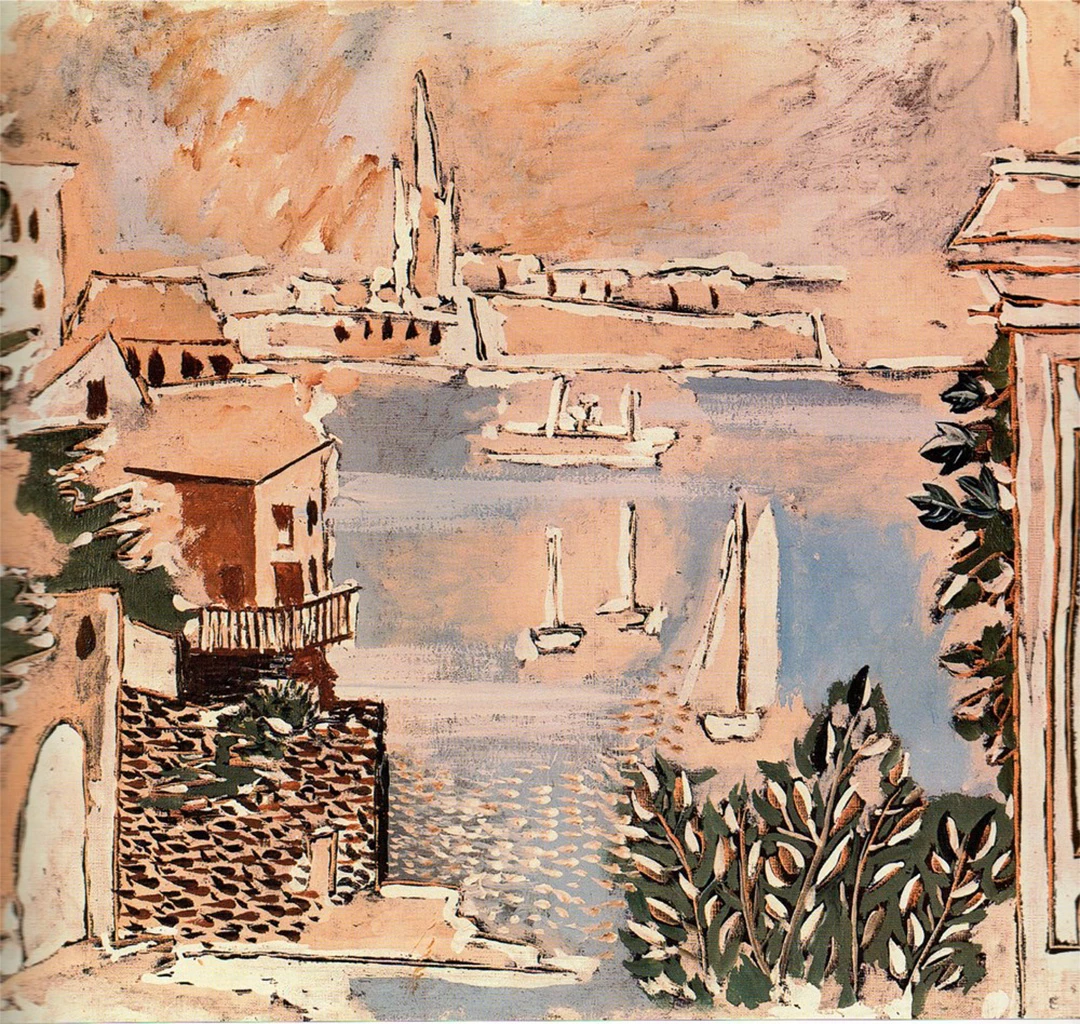
View of Dinard by Pablo Picasso. He stayed twice at the Gallic, in the 30s. An ultra modern hotel for its time, since almost all the rooms had a bathroom. A great first.
The First World War dealt a first major blow to Dinard, which was born of an aristocratic way of life that disappeared with the war. Between 1914 and 1918, the hotels were transformed into hospitals. The Roaring Twenties saw the return of tourists and parties were held in many villas, including the one that has become the town hall nowadays. The 30's saw the birth of the "dike" and the "promenades" which allowed people to walk along the coastline. The 1929 crisis dealt a new blow to the city when the British, ruined, sold their homes and the coup de grace was given by the Second World War.
The rebirth
Dinard / Photo choisie par monsieurdefrance.com : Shutterstock
After a difficult period, when tourists preferred more modern resorts, Dinard was finally reborn at the end of the 80s. This period of "oblivion" allowed Dinard to avoid what happened to other seaside resorts: the destruction of its heritage. No brand new buildings in place of an old villa since the city is not in demand. With the return of tourist interest in the 1990s, the mayor of the time, Marius MALET, had the idea of protecting the town from destruction and had several hundred villas classified. A "dinardais style" is imposed on all new constructions. International cultural events are set up such as the British Film Festival (which first saw "Love Actually" or "4 weddings and a funeral"), the piano festival or the fashion festival. Dinard shines again. And for a long time...
Where is Dinard ? Geo Info / Websites
Dinard is populated by a little less than 10 000 dinardaises and dinardais. It is located in the department of Ille-et-Vilaine and in the region of Brittany. The tourist area of Dinard is the Emerald Coast.
Go to Dinard by train.
There is no train station in Dinard. The nearest TGV station is Saint Malo and puts you at an average of 2H36 from Paris Montparnasse. Buses or cabs are available to reach Dinard. You can, for example, go up from the station to Intra muros by bus, take the boat bus at the foot of the ramparts to the Porte Saint Vincent, and arrive in Dinard by water. It is necessary to count 1H all included.
Go to Dinard by the road
By car, you are about 35 minutes from Mont Saint Michel, 45 minutes from Rennes, 4H30 from Paris (via the A13 Caen) or even 4H40 (via the A81) or 5H20 in a route without tolls). Buses allow you to come from Rennes.
Go to Dinard by plane
There is the airport of Dinard. It is located in Pleurtuit. It offers some destinations, notably to Great Britain. Here is the link to discover the destinations. There is also an airport in Rennes, the airport of Rennes Saint Jacques, at 1H00 from Dinard by road.
Websites :
The site of the tourist office of Dinard is here.
The site to visit Brittany is here.
Please excuse our translator. He partied in Dinard (yes! It's also a great town for evening fun)... As a result, he's not very fresh and he may have made some translation mistakes.
Sunrise over Dinard and Saint Malo / Photo chosen by Monsieurdefrance.com : Jérôme Prod'homme.




